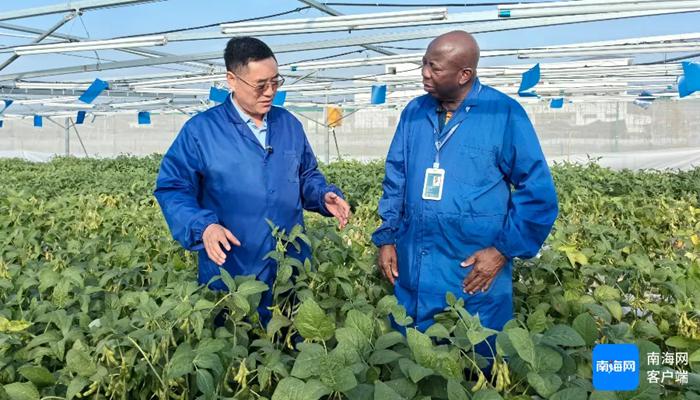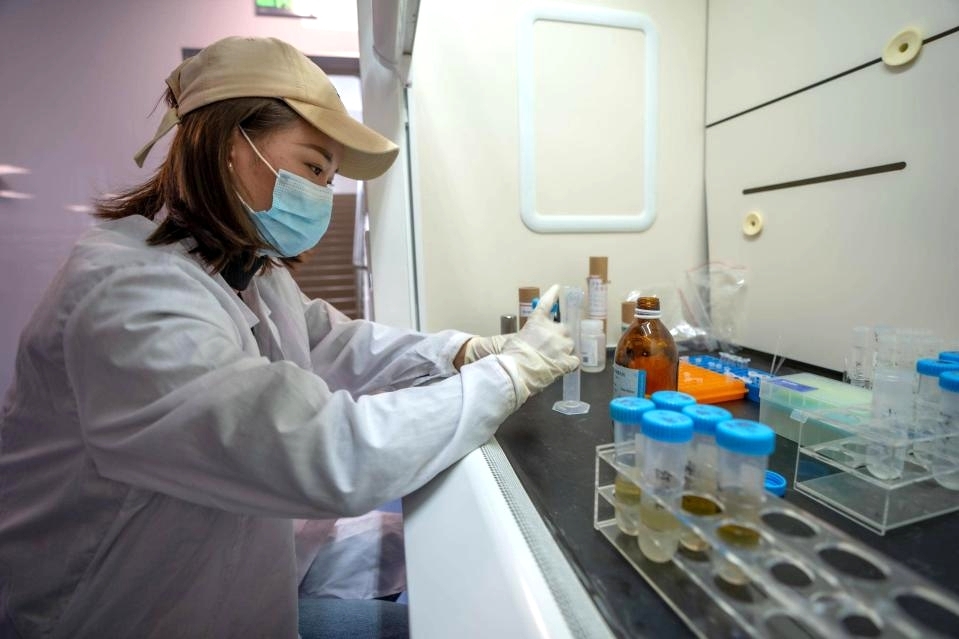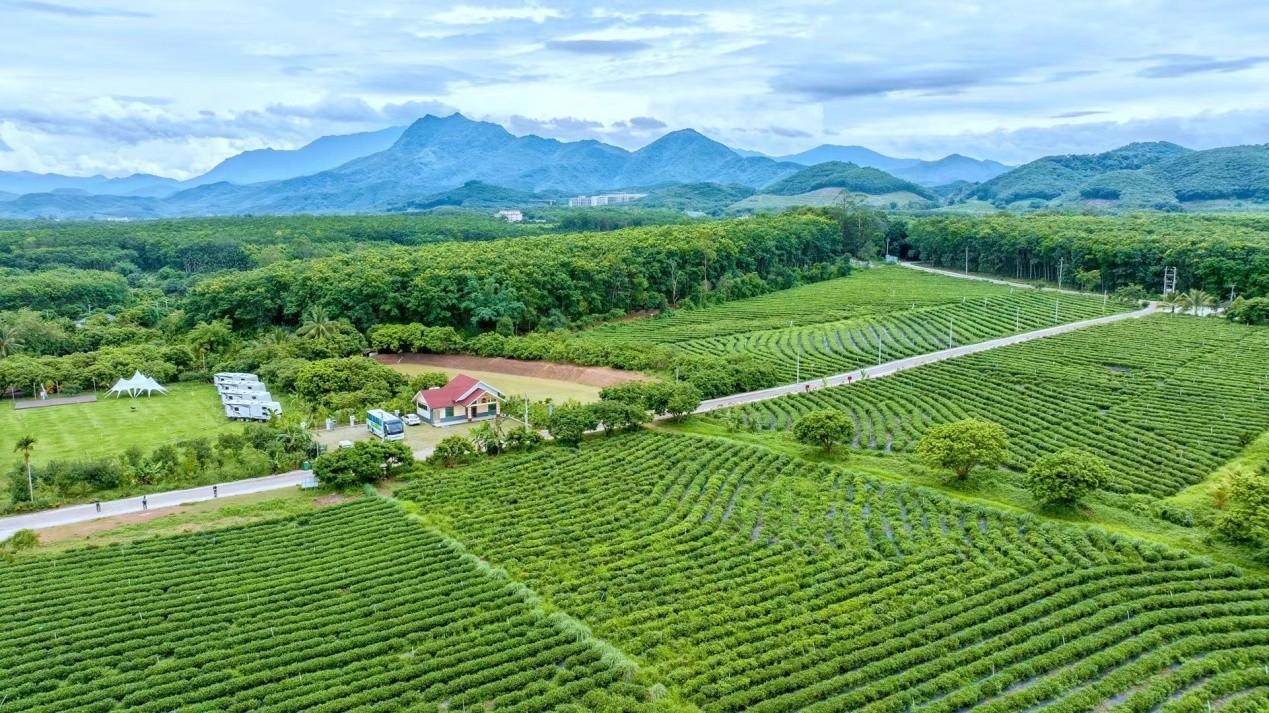Breeding innovation expands soybean potential nationwide

Han Tianfu poses for a picture with soybeans he breeds in Sanya, south China's Hainan province. (Photo/Li Shengfu)
Recently, at the experimental base of the Chinese Academy of Agricultural Sciences' (CAAS) National Nanfan Research Institute in Sanya, south China's Hainan province, researcher Han Tianfu and his team at the CAAS Institute of Crop Sciences held a "birthday celebration" for several unusual soybean plants.
Sown in November last year, these plants have matured into robust specimens reaching two meters in height with thick, sturdy stems. These "soybean trees" are the culmination of years of dedicated research.
As chief expert of the CAAS' National Nanfan Research Institute's innovation team for soybean breeding technologies, Han has studied soybeans for over 30 years.
He explained that soybeans exhibit high sensitivity to day length (photoperiod) and temperature. They detect the subtle shortening of daylight and lengthening of night following the summer solstice, triggering flowering and pod formation. This inherent sensitivity typically requires 10-12 years to develop a new, high-quality soybean variety.
To accelerate this lengthy process, Han's team moved their main breeding work to the Nanfan breeding base in Sanya, where light and temperature conditions make the region a natural "accelerator" for crop breeding.
This approach -- taking advantage of the favorable climate in southern Hainan to advance generations, propagate materials, and conduct identification tests -- is known as Nanfan, which literally means "breeding in the south."
Since the founding of the People's Republic of China, more than 70 percent of all new crop varieties have utilized Nanfan. Each winter and spring, large numbers of agricultural researchers bring breeding materials to Hainan, shortening the breeding cycle by one-third to one-half.
However, soybeans are classic short-day crops. When many northern varieties are brought to low-latitude Hainan, they flower prematurely and remain too short for essential hybridization work, the very foundation of developing improved varieties.
Drawing on their understanding of the soybean biological clock, Han's team combined this knowledge with modern LED supplemental lighting to create an artificial "long-day" environment in Hainan. This allows northern soybean varieties -- otherwise unsuited to the local climate -- to grow tall and vigorous, providing strong female parents for large-scale hybridization.
At the same time, the team has built China's first core soybean pollen bank, storing collected pollen at low temperatures for year-round use. This innovation extends the hybridization window from a mere two weeks per year to year-round operation.

Han Tianfu exchanges experiences with a foreign expert on soybean breeding. (Photo/Li Shengfu)
These breakthroughs have enabled Han's team to develop an engineered breeding system achieving multiple annual generations under field-scale conditions. Global soybean germplasm now converges in Sanya, compressing breeding cycles from 10-12 years to approximately seven years.
"By integrating domestic and international germplasm, we have developed varieties ranging from long-juvenile lines that can grow into 'soybean trees' in the tropics to ultra-early-maturing varieties suited to climates at 55 degrees north latitude. From south to north, we have expanded the adaptive boundaries of soybeans and laid a solid germplasm foundation for Chinese soybeans to 'go global,'" Han said.
The team is now incorporating artificial intelligence and genomic selection into breeding processes, enhancing precision and efficiency. The two-meter soybean plant represents not just scientific achievement, but symbolizes China's breeding industry innovation in Hainan.
In recent years, Sanya has focused on national strategic needs, accelerated the development of Yazhou Bay Science and Technology City, and made every effort to build a "Silicon Valley" for Nanfan, transforming the region from a seasonal site for advancing generations into an integrated innovation hub that supports research, production, exchange, and commercialization.

A researcher conducts an experiment at the Yazhou Bay Seed Laboratory in Yazhou Bay Science and Technology City, Sanya, south China's Hainan province. (Photo/Yuan Chen)
Today, Hainan is shifting from a seasonal "breeding base" into a seed-industry "Silicon Valley" that attracts top global talent and technologies. The emerging "Nanfan Silicon Valley" now features not only standardized breeding fields, but also seed laboratories, germplasm resource banks, and high-throughput phenotyping platforms. Researchers can now be stationed there year-round, carrying out full-process research and development from gene discovery to variety testing, dramatically improving breeding efficiency.
This transformation will significantly strengthen China's capacity for original innovation in the seed industry and provide a firmer germplasm foundation for safeguarding national food security.
Photos
 Int'l delegation explores organic tea culture in Baisha, S China's Hainan
Int'l delegation explores organic tea culture in Baisha, S China's Hainan Chamber Concert of Chinese Classical Music held at China Cultural Center in Kuwait
Chamber Concert of Chinese Classical Music held at China Cultural Center in Kuwait 27th Harbin Ice-Snow World to officially begin construction in NE China
27th Harbin Ice-Snow World to officially begin construction in NE China Promotion week for intangible cultural heritage brands opens in Dali, China's Yunnan
Promotion week for intangible cultural heritage brands opens in Dali, China's Yunnan
Related Stories
- Digital innovation breathes?new life into cultural heritage
- Chinese cities dominate global science hub rankings
- Bayer opens first innovation center in China
- China tackles "Darwin's Dead Sea" of innovations with new pilot platform push
- China's journey of innovation and rejuvenation: Reaping the fruits of four decades of investment in science, technology, and education
- Steady growth of BSE firms highlights China's growing innovation vitality
- Hong Kong sci-tech forum gathers young scientists amid innovation hub drive
- Chinese firms have vital say in global innovation
- China's light industry benefits from smart manufacturing, innovation
- China's 'innovation boom'?brings more?opportunities
Copyright © 2025 People's Daily Online. All Rights Reserved.





